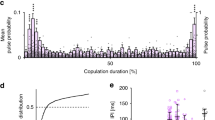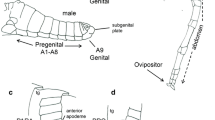Abstract
Typically three events occur when Octopus vulgaris Cuvier mates. The male inserts its hectocotylus into the mantle cavity of the female; the hectocotylus and the bodies of the male and female become quiescent; and the female increases its ventilation rate about 2.5 times, on the average, above its precopulatory base rate. It is hypothesized that the increased ventilation rate of the female provides the stimulus to the male to transfer its spermatophore to the oviduct. Since the insertion of the hectocotylus and the female's increased ventilation rate may be dissociated, it is suggested that copulation be defined as the attachment of the hectocotylus to the oviduct. A conditioned ventilation-rate increase in the female was observed with repeated testing. Observation of arching and pumping movements of the male as well as measurements of its ventilation rate before and during copulation indicate that only a few spermatophores are transferred per copulation.
Similar content being viewed by others
Literature Cited
Baglioni, S.: Zur Kenntnis der Leistungen einiger Sinnesorgane und des Zentralnervensystems der Cephalopoden und Fische. Z. Biol. 53, 255–286 (1909).
Bauer, V.: Einführung in die Physiologie der Cephalopoden. Mitt. zool. Stn Neapel 19, 149–267 (1908).
Bergmann, W.: Das Receptaculum seminis bei Octopus defilippi und einige biologische Beobachtungen. Sitzber. Ges. naturf. Freunde Berl. 1903, 104–109 (1903).
Borer, K. T. and C. E. Lane: Oxygen requirements of Octopus briareus Robson at different temperatures and oxygen concentrations. J. exp. mar. Biol. Ecol. 7, 263–269 (1971).
Drew, G. A.: The structure and ejaculation of the spermatophores of Octopus americana. Pap. Dep. mar. Biol. Carnegie Instn Wash. 13, 33–47 (1919).
Fischer, H.: Note sur le bras hectocotylisé de l'Octopus vulgaris Lamarck. J. Conch., Paris 42, 13–19 (1894).
Fox, D. L.: An illustrated note on the mating and egg-brooding habits of the two-spotted octopus. Trans. S Diego Soc. nat Hist. 9, 31–34 (1938).
Hirayama, K.: Influence of nitrate accumulated in culturing water on Octopus vulgaris. Bull. Jap. Soc. scient. Fish. 32, 105–111 (1966).
Kollmann, J.: Die Cephalopoden in der Zoologischen Station des Dr. Dohrn. Z. wiss. Zool. 26, 1–23 (1876).
Mangold-Wirz, K.: Biologie des céphalopodes benthiques et nectoniques de la Mer Catalane. Vie Milieu (Suppl.) 13, 1–285 (1963).
Mann, T.: 5-Hydroxytryptamine in the spermatophoric sac of the octopus. Nature, Lond. 199, 1066–1067 (1963).
—, A. W. Martin and J. B. Thiersch: Spermatophores and spermatophoric reaction in the giant octopus of the North Pacific, Octopus dofleini martini. Nature, Lond. 211, 1279–1282 (1966).
Packard, A.: Sucker display of Octopus. Nature, Lond. 190, 736–737 (1961).
The behaviour of Octopus vulgaris. 1st Cong. Int. D'Aquariologie, Monaco. Vol. D, 35–49 (1963).
Pelseneer, P.: Essai d'ethologie zoologique d'après l'étude des molluques, 622 pp. Bruxelles: Palais des Academies 1935.
Polimanti, O.: Sui rapporti fra peso del corpo e ritmo respiratorio di Octopus vulgaris Lam. Z. allg. Physiol. 15, 449–455 (1913).
—: Sur le sens chromatique de “Octopus vulgaris Lam.” recherché au moyen de réactions dans le rythme respiratoire. Archs ital. Biol. 64, 293–305 (1915).
Racovitza, E. G.: Sur l'accouplement de quelques céphalopodes Sepiola rondeletii (Leach), Rossia macrosoma (d'Ch.) et Octopus vulgaris (Lam.). C.r. hebd. Séanc. Acad. Sci., Paris 118, 722–724 (1984a).
—: Notes de biologie. Accouplement et fécondation chez l'Octopus vulgaris Lam. Archs Zool. exp. gén. 2, 23–49 (1894 b).
Robson, G. C.: On the hectocotylus of the cephalopoda — a reconsideration. Proc. malac. Soc. Lond. 17, 117–122 (1926).
Ross, D. M.: Protection of hermit crabs (Dardanus spp) from octopus by commensal sea anemones (Calliactis spp). Nature, Lond. 230, 401–402 (1971).
Steenstrup, J.: Hectocotylus-formation in Argonauta and Tremoctopus explained by observation on similar formations in the Cephalopoda in genera. Ann. Mag. nat. Hist. (Ser. 2) 20, 81–116 (1857).
Vebers, H. G.: Observations on the laying and hatching of Octopus eggs in the society's aquarium. Proc. zool. Soc. Lond. 137, 311–315 (1961).
Von Orelli, M.: Die Übertragung der spermatophore von Octopus und Eledone (Cephalopoda). Revue suisse Zool. 69, 93–102 (1962).
Walker, J. J., N. Longo and M. E. Bitterman: The octopus in the laboratory. Handling, maintenance, training. Behav. Res. Meth. Instrum. 2, 15–18 (1970).
Wells, M. J.: Brain and behaviour in cephalopods, 171 pp. Stanford, California: Stanford University Press 1962.
— and J. Wells: Hormonal control of sexual maturity in Octopus. J. exp. Biol. 36, 1–33 (1959).
—: Optic glands and the state of the testis in Octopus. Mar. Behav. Physiol. 1, 71–83 (1972a).
—: Sexual displays and mating of Octopus vulgaris Cuvier and O. cyanea Gray and attempts to alter performance by manipulating the glandular condition of the animals. Anim. Behav. 20, 293–308 (1972b).
Wodinsky, J.: Breeding season of Octopus vulgaris. Mar. Biol. 16, 59–63 (1972).
Wood F. G. Jr.: Observations on the behavior of Octopus. Int. Congr. Zool. 16, p. 73 (1963).
Young, J. Z.: Courtship and mating by a coral reef octopus (O. horridus). Proc. zool. Soc. Lond. 138, 157–162 (1962).
Author information
Authors and Affiliations
Additional information
Communicated by J. Bunt, Miami
Rights and permissions
About this article
Cite this article
Wodinsky, J. Ventilation rate and copulation in Octopus vulgaris . Marine Biology 20, 154–164 (1973). https://doi.org/10.1007/BF00351454
Accepted:
Issue Date:
DOI: https://doi.org/10.1007/BF00351454




